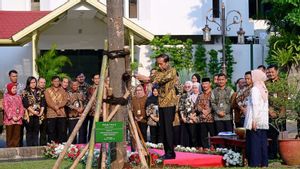YOGYAKARTA - Rare earth elements (REE) are a set of 17teen metal elements. This includes fifteen lantanides on periodic tables plus skandium and itrium. Then what is rare earth metal?
Rare earth elements are an important part of many high-tech devices. The release of the US Geological Survey news "Going Critical" explains:
"Frequent groundwork (REE) is an important component of more than 200 products in various applications, especially high-tech consumer products, such as mobile phones, computer hard drives, electric and hybrid vehicles, as well as flat screen monitors and televisions. Significant defense applications include the electronics display, guidance systems, lasers, as well as radar and sonar systems. Although the number of REEs used in a product may not be an important part of the product based on weight, value, or volume, REEs can be required for the device to function. For example, magnets made from REEs often represent only a small fraction of the total weight, but without them, spindel motors and desktop and laptop sound coils would not be possible.
In 1993, 38 percent of the world's REE production was in China, 33 percent in the United States, 12 percent in Australia, and five percent in Malaysia and India, respectively. Several other countries, including Brazil, Canada, South Africa, Sri Lanka, and Thailand, were the remainder. However, in 2008, China accounted for more than 90 percent of the world's REE production, and in 2011, China accounted for 97 percent of world production. From 1990 onwards, REE supply became a problem as the Chinese Government began to change the number of REEs allowed to be produced and exported. The Chinese government has also begun to limit the number of joint venture companies China and Sino-asing that can export REE from China."
Discovery and history
Although rare soil has existed since the formation of Earth, its existence was only revealed in the late 18th century. In 1787, Swedish army lieutenant Carl Axel Arrhenius discovered a unique black mineral at a small mine in Ytterby (a small town near Stockholm). The mineral was a mixture of rare earth, and the first individual element isolated was cerium in 1803.
The history of each element of rare soil is complicated and confusing, especially because of its chemical similarities. Many "newly discovered elements" are not one element but a mixture of six different rare earth elements. In addition, there are claims of discovery of a large number of other "elements", which should be members of rare earth series but not.
The rare earth elements that occurred naturally were discovered in 1907, but the chemical research of these elements was difficult because no one knew how many rare earth elements really existed. Fortunately, in 1913'14's research by Danish physicist Niels Bohr and British physicist Henry Gwyn Jeffreys Moseley settled this situation. The theory of Bohr's hydrogen atom allowed theorists to show that there were only 14 lantanides. Moseley's experimental studies verified the existence of these 13 elements and showed that the 14th lantanides must be elements of 61 and lie between neodymium and Samarium.
In the 1920s, the search for elements 61 was very intensive. In 1926 a group of scientists at the University of Florence, Italy, and at the University of Illinois claimed to have discovered elements of 61 and named elements of florentium and illinium, respectively, but their claims were not independently verifiable. The excitement of these claims and claims of retaliation finally subsided in 1930. Only in 1947, after uranium fission, that element 61 was completely isolated and named as a prometium by scientists at the Oak Ridge National Laboratory of the US Atomic Energy Commission in Tennessee. (Further details on the discovery of individual elements were found in articles on those elements.)
SEE ALSO:
During 160 years of discovery (17871947), separation and purification of rare earth elements is a difficult and time-consuming process. Many scientists spend their entire life trying to get 99 percent of pure rare soil, usually with fractional crystallization, which takes advantage of the slight difference in solubility of rare earth salt in aqueous solutions compared to neighboring lantanid elements.
Since soil elements are rarely found as fission products of atomic segregation of uranium, the US Atomic Energy Commission is trying hard to develop new methods to separate rare earth elements. However, in 1947 Gerald E. happened to be and his colleagues at Oak Ridge National Laboratory and Frank Harold Spedding and colleagues at Iowa Laboratory simultaneously published results showing that ion exchange processes offer a much better way to separate rare earth metals.
So after knowing what rare earth metals are, see other interesting news on VOI, it's time to revolutionize news!
The English, Chinese, Japanese, Arabic, and French versions are automatically generated by the AI. So there may still be inaccuracies in translating, please always see Indonesian as our main language. (system supported by DigitalSiber.id)
















